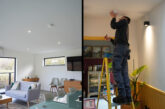
Andy Speake, National Technical Manager at Aico, explores the recently revised British Standard for domestic fire alarms and what this means for contractors.
BS 5839-6 is the code of practice for the design, installation, commissioning and maintenance of fire detection and fire alarm systems in domestic premises. Since its introduction in 1995, BS 5839-6 has been adopted as standard practice in both existing dwellings and new builds; its importance can’t be over-emphasised!
A new version of BS 5839-6 was released on April 30th, which has some major changes. These relate to the Grades of alarms, which determine the type of alarm to be used, and the Category, which identifies the type/level of protection for each identified dwelling.
Changes to Grades
Under BS 5839-6, Fire Alarms are classified into Grades, from A to F. Grades B and E have been removed, but with Grade D being the current most common for domestic properties I’ll focus on this.
Under the previous standard, Grade D required one or more interlinked mains powered Smoke Alarms (and Heat Alarms if required), each with an integral back-up supply; the back-up supply to be in the form of a rechargeable lithium or alkaline battery.
Under the revised BS 5839-6, Grade D has been replaced with Grades D1 and D2 which differ in terms of the back-up power supply:
D1 calls for a tamper-proof standby supply consisting of a battery or batteries, with lithium being the standard battery type. These are long life battery cells lasting the recommended
lifespan of the alarm and are designed so they can’t easily be removed by the user.
Grade D1 alarms are the preferred option for social housing as they remove the risk factor.
D2 requires an integral standby supply consisting of a battery or batteries (usually 9V PP3) which need to be replaced at regular intervals throughout the life of the alarm by the user.
Property types get new minimum levels of protection
Under BS 5839-6 different class of premises are identified and the minimum Grade of Fire Alarm system and Category of fire protection provided for that specific type of property are listed. It is here, in the 2019 revisions, that we’ve seen the biggest changes that will have a major impact on what type of Fire Alarms are fitted and where.
In the main this is due to an increase in the Category of fire protection from LD3 where previously listed, which requires one mains powered Optical Alarm in the hallway and another upstairs on the landing, interconnected together, to Category LD2. LD2 involves additional alarm coverage, with a Heat Alarm in the kitchen and a further Smoke Alarm in the main living area; once again all interconnected.
This upgrade in fire protection is most notable in existing rental properties and Houses in Multiple Occupation (HMOs):
Existing 2-3 storey maisonettes and houses in the rental sector have now been upgraded from the low Category of fire protection (LD3) to the medium Category LD2 and graded D1, i.e. mains powered alarm with tamper-proof battery back-up power. Properties
of this nature remain LD3, unless a risk assessment indicates otherwise.
Existing Houses in Multiple Occupation (HMOs) have been set as Category LD2, whereas before it was a mixture of LD2 and LD3 depending on the nature of the property and inhabitants. Grade D1 is now the requirement.
Other property types that have made an appearance in the BS 5839-6 property classification are supported housing and short-term holiday lets. Both are allocated the highest category of protection – Grade D1, LD1.
The increase in the level of fire protection required in these instances means additional alarms per property which has an associated cost, not just in alarm units but also installation. Some of this cost can be mitigated by using wireless alarm interconnection technology, such as Aico’s RadioLINK+ and SmartLINK, and by using alarms that have been designed to be quick and easy to install.
Larger systems also benefit from an Alarm Controller, which enables all alarms on a system to be tested and silenced from a single point, as well as a located feature to identify the precise alarm which originally triggered.
BS 5839-6:2019 builds on the success of the original standard and, if adhered to properly, ensures greater safety and even better practice in the industry.
Aico has added a useful page to its website, offering you all the details you need to know about the revised changes to BS5839-6. To access it, go to: www.aico.co.uk/bs5839-6/










